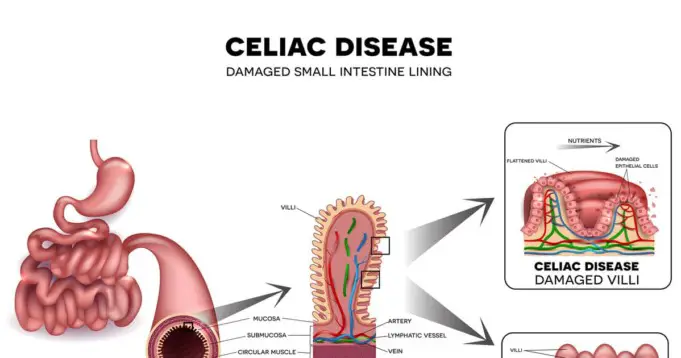Celiac disease – also known as Sprue, non-tropical sprue or Gluten-sensitive enteropathy – is an immune system disorder. It causes severe damage to the lining of the small intestine (intestinal villi) when we eat foods that contain the protein gluten.
There is currently no cure for celiac disease. Usually, people with untreated cases are unable to absorb nutrients from their food which can result in serious health complications such as malnutrition, infertility, and even cancer.
If you have celiac disease, the consumption of a small amount of gluten may damage your intestine even with the absence of any symptoms.
The damage caused by this disorder can often be reversed once you have been diagnosed and adhering to a gluten-free diet. This diet helps prevent intense autoimmune damage in people with celiac disease by avoiding foods that contain gluten.
Symptoms
There are over 200 potential symptoms of celiac disease. The condition is not only limited to your digestive system. It can also affect any part of your body system from your brain to your skin. While the disease has some general symptoms, they also vary by age and gender.
The most common symptoms include bloating, constipation or diarrhoea (sometimes alternating), abnormal pain, headaches (including migraines), and fatigue
The symptoms in children include:
- Vomiting
- Weight loss
- Abdominal pain
- Abdominal bloating
- Foul-smelling, pale or fatty stools
- Feeling tired and irritable
- Slow growth and delayed puberty
Celiac disease symptoms in adults include:
- Joint stiffness and pain
- Iron-deficiency anaemia
- Weak, brittle bones
- Seizures
- Fatigue
- Tingling and numbness of the hands and feet
- Skin disorders
- Pale sores inside the mouth
- Infertility and miscarriage
- Irregular menstrual periods
- Tooth discolouration/ loss of enamel
Another common symptom of celiac disease is dermatitis herpetiformis (DH). DH is an extremely itchy skin rash made up of blisters and bumps.
It may develop on the buttocks, knees, and elbows. Approximately 15 to 25 percent of celiac disease patients experience DH. Those who are affected by DH don’t usually have digestive symptoms.
- It is also important to note that symptoms can vary per person depending on several factors, including
- The duration of breastfeeding during infancy
- The age at which the person started eating gluten
- The amount of gluten intake
- The level of intestinal damage
Some people also have celiac disease with no symptoms. This is called silent celiac disease. While the silent celiac disease has no visible symptoms, affected persons still develop intestinal damage as a result of the condition.
Diagnosis
The diagnosis process begins with a medical history and a physical examination. Various tests will also be carried out to help confirm a diagnosis.
People with this disorder often have high levels of anti-tissue transglutaminase (tTGA) and antiendomysium antibodies, which can be detected through blood tests. You must be on a gluten-containing diet for results to be accurate.
Common blood tests include;
- Liver function tests
- Complete blood count (CBC)
- Cholesterol test
- Serum albumin test
- Alkaline phosphatase level test
A skin biopsy can also assist doctors in diagnosing celiac disease in people with DH. A skin biopsy is done by removing and examining tiny pieces of skin in a microscope. An internal biopsy may not be necessary if the blood test and skin biopsy results indicate celiac disease.
An upper endoscopy may be used in cases where skin biopsy or blood test results are inconclusive. An upper endoscopy is done by inserting a threading a tiny tube called endoscope down into the small intestines, through the mouth.
The doctor can assess the extent of damage to the intestines and villi through a camera attached to the endoscope. An internal biopsy can also be carried out by examining a tissue sample taken from the intestines.
Treatment
Excluding gluten from your diet is the only way to treat celiac disease. This prevents further damage to the lining of your gut and helps reduce symptoms, such as diarrhoea and most times, stomach pains.
It also enables the intestine lining to heal and start absorbing nutrients normally. You must avoid any source of gluten if you want to get better.
Your doctor or a nutritionist can assist you in planning a gluten-free diet. They’ll teach you how to identify foods and ingredients that contain gluten by reading labels on food and products.
Managing Symptoms of Celiac Disease
This disease has no exact cure, but people can manage their symptoms by adhering to a gluten-free diet. However, it isn’t an easy task sticking to a gluten-free diet.
Fortunately, a lot of manufacturers are now producing gluten-free products which can be purchased from various online food stalls and on-ground grocery and specialty stores. These products are labelled “gluten-free.”
Here is a series of food guidelines that can help you identify foods that are gluten-free and foods that aren’t.
Ingredients to avoid;
- Semolina
- Wheat
- Barley
- Rye
- Triticale
- Spelt
- Graham flour
- Farina
- Durum
- Bulgur
Foods to Avoid (unless labelled gluten-free);
- Beer
- Cookies
- Oats
- Malt
- Soup
- Pasta
- Cookies
- Bread
- French fries
- Sauces
- Gravies
- Cookies
- Cakes and pies
- Crackers
- Imitation seafood or meats
- Processed lunch meats, hot dogs or sausages
- Croutons
- Salad dressings
- Sauces (including soy sauce)
Grains and starches that are gluten-free;
- Tapioca
- Quinoa
- Flour made from beans, corn, potatoes, rice or soy
- Pure corn tortillas
- Cornmeal
- Arrowroot
- Corn
- Buckwheat
- Amaranth
- Rice
Gluten-free Foods to Eat;
- Eggs
- Vegetables
- Rice
- Lentils
- Nuts
- Beans
- Fruits
- Healthy fats
- Buckwheat
- Legumes
- Herbs
- Diary
- Unprocessed meat and fish
- Starchy veggies ( peas, potatoes, corn)
- Wine distilled spirit, liquors, and ciders.












